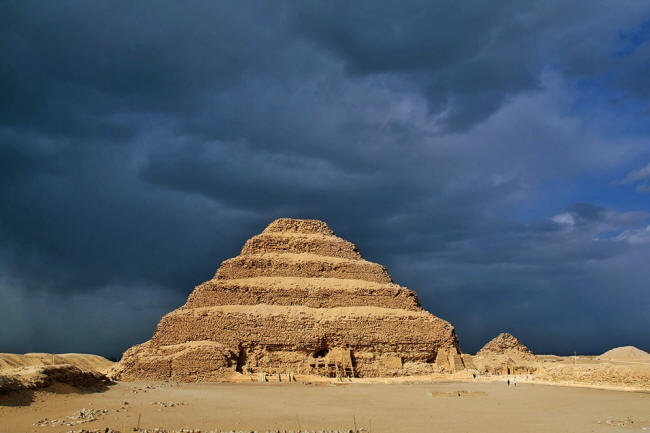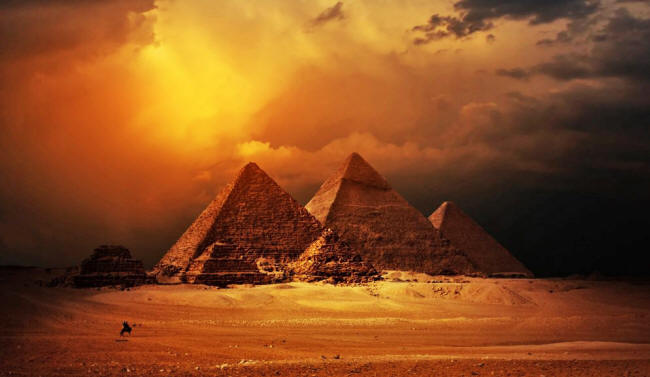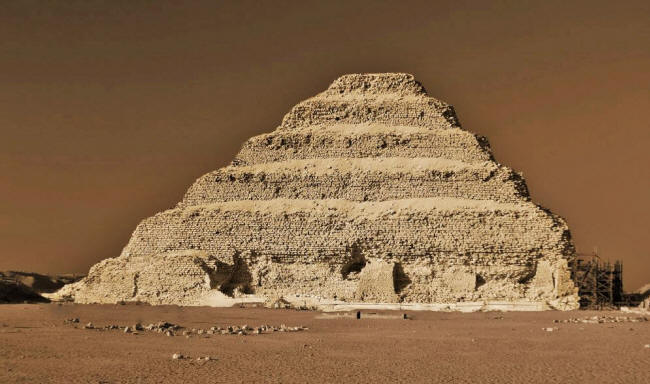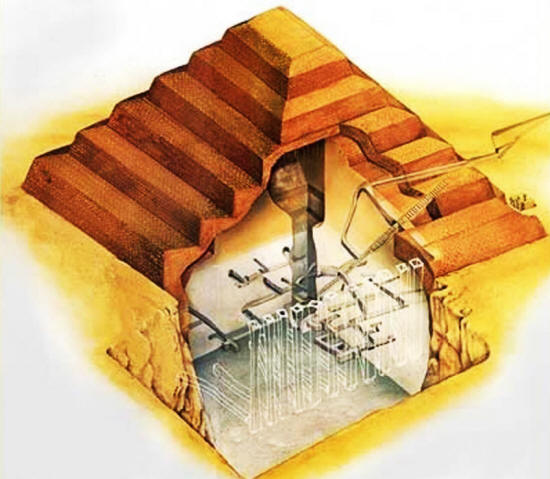|

by Petri Pixel
January 31,
2020
from
Curiosmos Website

The
entire pyramid complex
covers 15 ha (37
acres) and is about
2.5 times as
large as
the Old Kingdom
town
of Hierakonpolis...
Egypt is a land of treasure.
For thousands of
years, during a time when history was not even recorded, great
cultures walked across the Egyptian land.
Mighty civilizations
developed, creating piece by piece a history that we would
eventually come to cherish.
The land of Pharaohs, mummies, pyramids and golden sand offers
something that no other place offers:
a trip to the
past through its many majestic monuments, some of which
remained buried beneath the surface for thousands of years.
If you ask any traveler
today what has impacted him the most while visiting Egypt, you'd
probably get more than one answer.
Some people would argue that the Egyptian pyramids are beyond a
reason of a doubt the most impressive feature of Egypt's ancient
history. Others would say that the very core of their history is
more than enough to leave a lifelong impact.
Egypt has a lot to offer.
From sunken cities,
massive temples built with nearly impossible stones, the
pyramids, great Kings and rulers throughout its history, to
their impeccable knowledge in various fields of science.
Although the ancient
Egyptian civilization achieved so much during their long history,
their biggest and most impressive achievement are perhaps the
pyramids.

Shutterstock.
To date, experts argue that there are around 120 pyramids scattered
across Egypt.
The most impressive
pyramids are certainly those at Giza, thought to have been
constructed during Egypt's Fourth Dynasty.
As revealed by archeologists, and following their strict timeline,
Egypt's truly gigantic pyramids were built over the course of no
more than three generations, starting with the Third Dynasty King
Sneferu, followed by his son Khufu, and Sneferu's grandson Khafre.
Advertisement
If the mainstream view on Egypt's history is correct than Sneferu
was Egypt's most prolific pyramid builders. He is thought to have
erected a total of three massive pyramids:
One at Dahshur, and
two at Meidum.
Sneferu's pyramids alone
contain more than 3.5 million cu. meters of stone.
This means that all other
Egyptian pyramids combined (except the queens' pyramids and
satellite pyramids) contain only 41 percent of the total mass of the
pyramids of Sneferu, his son Khufu and grandson Khafre.
Although Menkaure - the King who is thought to have built the
third-largest pyramid at Giza - still used multi-ton blocks of stone
in his pyramid, the total volume of his pyramid is far less than the
total volume of Egypt's first pyramid, the Step Pyramid at
Saqqara...
A pyramid and
a vast underground world
Although many people believe that
the Great Pyramid is Egypt's oldest pyramid, the first
such structure built in Egypt was completed around 4,700 years ago,
during Egypt's 'Third Dynasty'...
The structure was supposedly commissioned by Djoser early in his
reign.
To build it, the king is
said to have turned to his royal vizier and architect
Imhotep.
The young man had revolutionary ideas in architecture that were
apparently recognized by
Djoser.
He ordered the monument to be built at the royal necropolis of
Saqqara, not far from Giza, where the most impressive pyramids of
Egypt would be built within 200 years of Djoser.
The
Step Pyramid was revolutionary...
Never before had Egypt seen a structure of similar design, built
entirely out of stone.
Mainstream scholars see Djoser's Step Pyramid
as the earliest colossal stone building in Egypt, and the oldest
large-scale cut stone construction in history.

Shutterstock.
To build a structure like that of Imhotep, a never-before-seen
workforce was gathered.
It was no small
project, and for a young architect, it was a major undertaking.
In fact, experts say that
the social implications of such a massive, carefully sculpted
structure are staggering, pointing towards the fact that the royal
government of the time had complete control of not only natural
resources but both material and human as well.
The entire pyramid complex is believed to have been completed in
around 19 years, which suggests that Djoser probably ruled long
enough to see his master-plan complete.
The pyramid began perhaps not as one from the beginning.
Experts believe the
structure Imhotep designed first resembled a kind of square
mastaba.
This is the most
important tell-tale sign that the monument was not meant to be a
mastaba. Egyptologists say that there are no known square
mastabas anywhere in Egypt.
This probably suggests Imhotep as have "played around" with the
design of the monument.
Although he probably
knew he would not create a mastaba, it is unknown whether he
envisioned building a pyramid, or whether or not this was just a
random result of him experimenting with the structure.
After all, the Step
pyramid is regarded as a proto-pyramid.
It has been suggested
that the Step Pyramid was constructed in six distinctive stages.
Beginning as a square
mastaba, the structure was gradually enlarged by Imhotep first
evenly on all four sides, and later just on its eastern point.
Each step is thought to have been experimental.
The "morphed" mastaba was most likely constructed in two stages,
first to form a four-stepped structure (P1) and then to form a
six-stepped structure (P2), which a clear rectangular base
aligned on an east to west axis.
Most of the construction
material for the pyramid was quarried near the construction site,
and the builders did not have to worry about transporting extremely
large stones across vast distances, like the builders of the Great
Pyramid.
Although the pyramid was the most impressive feature at the complex,
many other important and equally majestic buildings decorated it.
The structures at the
center were surrounded by a massive wall built using light Tura
limestone 10.5 m (34 ft) high. This wall is interrupted by 14 doors
but had only one entrance.
The entire complex was truly massive; experts estimate it covers 15
ha (37 acres), which means it is nearly 3 times as large as the Old
Kingdom town of
Hierakonpolis.

Underground Chambers beneath
the
Step Pyramid.
Image
Credit: Pinterest.
However, the most impressive feature of the entire pyramid complex
are not the above-ground elements but rather that which remains
hidden beneath the surface.
If the pyramid complex was so large that it resembled in size a town
of the Old Kingdom, then the underground world built beneath the
Step pyramid directly was a major metropolis.
For reasons we are unable to understand to date, Imhotep
constructed,
...a supermassive
labyrinth of tunnels, chamber, magazines, and rooms with a total
length of nearly 6 kilometers.
This massive
underground world was connected to an entrance shaft 5 meters
square, and 28 meters deep, located almost at the heart of the
Step Pyramid.
Egyptologists believe that this vast underground world beneath
the pyramid was meant to represent the funerary apartment that
mimicked the palace and would serve as the living place of
the
royal 'ka'.
However, while Djoser's
Step Pyramid is thought to have given birth to the pyramids of
Egypt, and many of its elements endured in future examples of
pyramids in Egypt, never again did any king construct a vast
subterranean world the size of that located beneath the Step
Pyramid.
In fact, never was it even attempted in future generations, and not
even the largest pyramids in Egypt, the
Red Pyramid, the Great Pyramid, nor
Khafre's pyramid featured such an impressive and complex underground
system.
The storage rooms beneath the Step Pyramid were home to more than
40,000 stone vessels which were curiously found to predate Pharaoh
Djoser by several generations.
|





